Purpose The purpose of this study is to investigate the factors for setting proper training duration of frequency that can guarantee the student athletes' right to study and performance, and to derive the ranks of setting proper training duration of frequency of student athletes by school level. Consequently, to provide basic data for the development of training guidelines for the growth period of Korean student athletes. Methods Delphi and Analytic Hierarchical Process(AHP) techniques were used. The Delphi survey was conducted in three phases, and collected data through Delphi survey were computed by SPSS win ver. 22.0 and Excel, using the mean, standard deviation, median, and coefficient of variation. Using the AHP technique, we classified the factors for setting proper training duration of frequency derived through Delphi survey, and calculated the importance by using Microsoft Excel 2010. Conclusion First, elementary students should be guaranteed regular class participation, have basic after school training, and be provided with adequate rest so that they do not lose interest in the exercise. Second, middle school students are required to decide whether to continue exercise based on their ability to exercise and abundant experience. Therefore, when abandoning the exercise, students should be able to faithfully carry out their academic performance. Third, high school students are directly related to college entrance and employment, so they have to concentrate on performance rather than on academic performance.

[Purpose] This study aims to examine necessity and characteristics of the K-OVEP, and discuss ways of settle and spread the program stably through cases applied in school settings. [Methods] To do so, educational components and curriculum of the K-OVEP was represented by analyzing references, developmental materials, and program application. This study was examined through the application process and observation of long-term program of the K-OVEP from two types of educational fields, 2 elementary schools and 2 middle schools. In order to examine if the K-OVEP achieves the aim of the IOC and the K-OVEP, basic level study was conducted to 187 students who participated in the program in 2016. The questionnaire consisted of three categories; ‘cognition part’ through the Olympic games and the Olympic values, ‘value part’ regarding five educational themes of the OVEP, and ‘interest part’ asking interest and involvement in sports activities, participants answered the questionnaire before and after the education. [Results] We found that K-OVEP is an integrated value based educational program regarding Olympics, stresses personality education, encourages students to explore their career, and is a process oriented education. The results showed that the K-OVEP achieved the educational goals in every categories and questions, and educational effects in sports activity looked different among schools and the environments. [Conclusion] This study was performed to participants at first year of the introduction of the K-OVEP, so in order to keep track of learners’ significant change continuously, expansion of participants, steady development of various new programs, development of assessment tools, experts training and follow-up studies will be required.

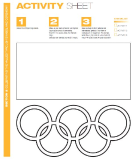
Purpose The purpose of this study is to explore the physical activity promotion plans for female student by revising and supplementing the SPARK program which is actively applied as a P.E physical activity improvement program recently. Methods To achieve this, this study followed the custom of action research and apprehended problem in female students' physical activity in SPARK soccer program(first action and examination), problem solving plan(replanning), execution and evaluation of replanned SPARK soccer program (second action and evaluation). The collection and analysis of data was conducted by sequential explanation strategy. Specifically, the study utilized 3 dimensional accelerometer to measure the physical activity in P.E class, and collected data which could apprehend the experience of students by utilizing qualitative study tools(observation, class note, interview). To analyze the collected data, the study utilized mixed-methods study analysis method developed by Greene(2007). Results The study results are as follows. As for the result of first action(October~November 2014), SPARK program increases the entire physical activity in P.E class, but the female students' activity was relatively lower than male students'. The reasons for lower physical activity of female students' were unmotivated class, burdensome class, alienated class. These were specified into teaching strategy to replan and execute the second action (May~June 2015). Compared to first action, the second action showed positive physical activity, and the MVPA of female students' showed statistical difference (<.01). As for the result of qualitative analysis, the positive grounds of second action are 1) motivative resource like "necessity", 2)hard but meaningful learning activity, and 3)kind P.E teacher. Conclusions In conclusion, the implementation of a soccer class with a modified supplement to the SPARK program can enhance physical activity of female middle school students.
The purpose of this study was to examine the current status of school sport club(SSC) participation and to explore relationship between school sport participation and positive youth development. In order to do this, a survey was conducted with 403 elementary, middle, and high school teachers who are currently taking charge of SSCs, and also individual interviews were conducted with 22 students. In addition, the youths' developmental asset questionnaire was administered with 412 middle school students. The survey results from 403 teachers showed that SSCs have potential to contribute to positive youth development because teachers are placing an emphasis on character development as well as physical and social development through SSC activities. In addition, participants who regularly participate in physical activities had higher internal and external developmental assets than non-participants or irregular participants. Specifically, students participated in SSC more than twice a week had higher internal and external assets than students participate once a week. In addition, participants who engage more than one hour per session had higher internal and external assets except constructive use of time and social competence. Discussion and implications for organizing SSCs to provide developmental contexts and contents for positive youth development were provided.
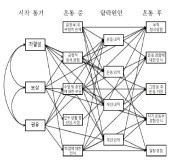
The purpose of this study is to explore the drop-out process of student-athletes and propose valuable policy ideas related to interscholastic sports. For this purpose, we surveyed 560 middle and high school drop-out student athlete's in 13 areas and finally 400 completed surveys were used for the study. To set the scales used for the study and test the reliability and validity of the scales, factor-analyses, Cronbach's alpha, and interfactor correlations were conducted using SPSS. For the main test, the paths analyses were carried out with AMOS program. As a result, we found two paths which had major effects on the drop-out process of student-athletes, self-efficacy path at the point of starting athletic career and negative relation path during athletic experiences. Based on these results, the following policy ideas were proposed. First, student-athletes should be able to join and leave athletic teams voluntarily. Second, the comfortable environments were provided to promote student-athletes' positive emotion toward athletic teams.

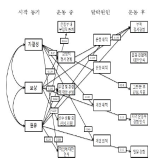



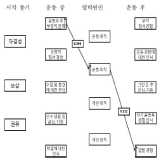

The purpose of this study was to analyze and confirm whether the items used in final paper and pencil test was determined to DIF when school sports clubs in each school operated by discriminatory curriculum in accordance with gender. Participants were 8th middle school students(male=135, female=141). They joined in school sports club every week from freshman to sophomore 1st semester. At that time, boys of them participated in soccer and basketball, and girls played dodge ball. They studied soccer unit at sophomore 1st semester, and had a final examination consisting of 5 soccer items. Using the data, differentially functioning item by the population difference between male and female were analysed quantitatively and qualitatively. The results showed that Mantel-Haenszel method(using classical test theory), comparison of item characteristic curve and likelihood ratio test(using IRT) determined item number 4 and 5 to differentially functioning item. Finally, item number 4 were identified differentially functioning item in favor of male students in intensive qualitative analyses. That item have low content validity and application-level of cognitive behavior classification. The result provides that application-level item can be functioning differentially to female students with little sports experience than male students in paper and pencil test of PE.

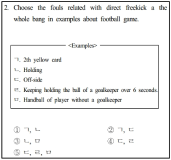
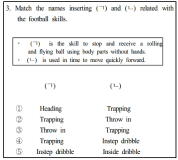
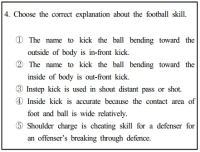
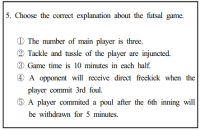
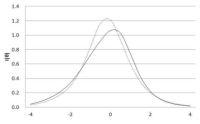
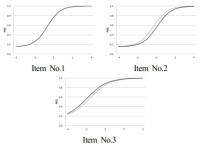

PURPOSE The purpose of this study was to develop a non-face-to-face self-regulation training program for middle and high school student-athletes through the conduct of a group online video counseling session, as well as to verify the effectiveness of such a tool. METHODS Based on the models of Zimmerman(2000) and Han Si-wan (2008), the 12-session non-face-to-face self-regulation training program consisting of interactions involving cognitive, emotional, and behavioral factors was developed and used on a 16-member experimental group. Additionally, self-regulation and mental toughness questionnaires were given to each member before and after the program, and the results were compared with the results of a 17-member control group. Since a qualitative evaluation was conducted, recorded training contents were organized into a text file; after which, a step-by-step coding procedure was performed, and then meanings and themes were identified and categorized. RESULTS Quantitative analysis found that the volitional inhibition mode of the control group decreased significantly; this was in comparison to the increase in the self-regulation mode of the experimental group. In addition, among the seven sub-factors of the mental strength test of the experimental group, a significant increase was found in the post-test of self-belief, attention control, emotional regulation, resilience, and optimism factors. As a result of qualitative data analysis, they complained of difficulties in the early stages of participation, but gradually recognized their problems and searched for changes, showed changes in cognition, emotion, and behavior as they approached the end of the study period. CONCLUSIONS It can be said that the non-face-to-face self-regulation training program helped student athletes improve their school life and performance by driving positive cognitive, emotional, and behavioral changes.

Purpose This study has four objectives. First, the study attempted to see if trainee teachers in PE experienced a higher level of burnout as their experience as trainee teacher accumulated. Second, the current study explored whether female trainee teachers experienced a higher level of burnout than their male counterpart. Third, the study examined whether self-efficacy of trainee teachers had a significant causal relationship on the level of burnout. Forth, the study looked into the possible moderating effect of motivation in the relationship between burnout and intention to change their career path. Methods The data for the study were collected from 112 trainee PE teachers of middle and high schools in Seoul and its vicinity. The data were analyzed with the SPSS statistical package. Results First, the trainee teachers’ level of burnout increased between 2nd week and 4th week and the increase was statistically significant except in the sub-dimension of depersonalization. Second, female trainee teachers showed a higher level of emotional exhaustion than their male counterpart. However, male trainee teachers showed a higher level of diminished personal accomplishment than their female counterpart. Depersonalization did not show any statistical mean difference between male and female groups. Among the four teacher self-efficacy sub-dimensions, only teaching competence showed statistically significant negative influence on emotional exhaustion. Lastly, trainee teachers’ level of motivation worked as a significant moderator in the relationship between emotional exhaustion and intention to change their career path.


Researchers and teachers in physical education have emphasized sportsmenship in sport education setting. However, how to teach sportsmenship in physical education is not proposed yet. The purpose of this study was (1) to develop an instructional program for teaching and learning sportsmanship and (2) to examine its effects on sportsmenship. Participants were 7th middle school students(N=95). Data were collected using Sportsmanship Test(Park, 2014), open-ended questionnaire and in-depth interviews with students. The data were analyzed through paired samples t-test and qualitative content analysis. Results showed that significant difference was observed in students' sportsmanship test scores after instruction. Analysis of interview data showed that students experience the value of utmost effort, respect for opponents, respect for teammates, acknowledging results, respect for judgment, and valuable lessons related to character education. Implications for sportsmanship education using instructional program were discussed.


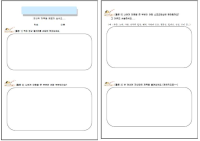
Purpose The purpose of this study was to investigate characteristics of levels of physical activity in considering gender and different types of competition-oriented physical activity classes using three-dimensional accelerometers. Methods A total of 981 students(505 male students, 476 female students) in six different types of physical education classes were participated in this study. All of the six different types of physical education classes were competition-oriented classes, and levels of physical activity were accessed by three-dimensional accelerometers. Data were analyzed using t-test and ANOVA. Results First, descriptive analyses of participation time of levels of physical activity showed that MVPA of physical education classes is 10.26 mins (22.89%) on average, and, MVPA showed differently in different types of physical education classes in the order of T ball(14.61 mins), flying disk(12.61 mins), soccer(10.78 mins), volley ball(10.56 mins), basketball(9.64 mins), and table tennis(5.73 mins). Second, female students showed significantly lower levels of MVPA in all the different types of physical education classes. Third, post-hoc analyses showed that significantly higher levels of MVPA were found in T ball physical education classes and significantly lower levels of MVPA were found in table tennis physical education classes, compared to other types of physical education classes. Conclusions MVPA in physical education classes is not satisfied with recommended MVPA, and MVPA in Korean physical education classes is lower than MVPA in same types of physical education classes in other countries. In addition, significant mean differences of MVPA are found between male and female students, and new sports physical education classes show higher levels of MVPA compared to classic sports physical education classes. These results indicate that competition oriented physical education classes widely used in Korea need to find ways to increase MVPA and to overcome different levels of MVPA between male and female students.